The Classic Heritage Trail
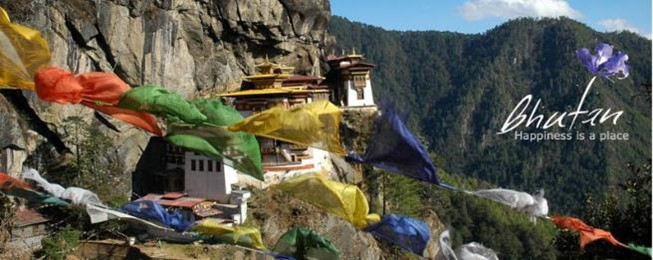
Bhutan is known to the world as the Last Shangri-La. The mighty Himalayas have shielded Bhutan from the rest of the world, leaving this Himalayan gem blissfully untouched. The Drukpa Kagyupa sect of Mahayana Buddhism has provided this country with a rich culture and a fascinating history. The Bhutanese people have safeguarded this sacred heritage and their unique identity for centuries, choosing to remain in carefully guarded isolation.
This country of rolling hills and imposing cliffs is full of charm. The mountains are breathtaking, the forests are dense, the people are charming, the air is pure, the architecture is inspiring, the religion is stirring, and the art is moving. Here, travelers encounter the full glory of this ancient land through its fortresses known as Dzongs, a great variety of ancient temples, monasteries, and stupas, prayer flags fluttering along high mountain ridges, abundant and diverse wildlife in its dense forests, white and foamy waterfalls, and the warm smile of its friendly people. With its beautiful and largely pristine Himalayan environment, rich flora and fauna, and vibrant Buddhist culture, Bhutan has become an increasingly popular destination for international travelers.
Useful Information and Facts:
Day by Day Program
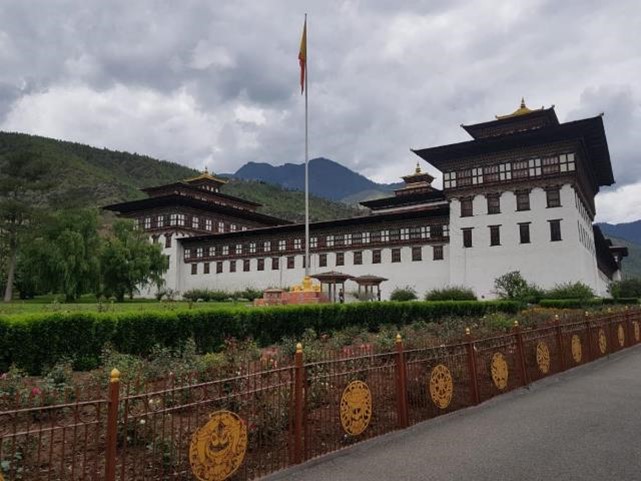
Day 01: Arrival in Paro (Bhutan) - By flight and transfer to Thimphu (55 km, approx. 1 ½ hours by car)
The flight to Paro is one of the most spectacular in the entire Himalayas. Flying along the Himalayan range from Kathmandu or over the foothills of the Himalayas if flying from Kolkata, the journey offers stunning views and an exciting descent into the Kingdom of Bhutan. The first gift of this country upon landing will be the fresh, clean mountain air.
After immigration formalities and luggage collection, our representative will welcome you with a 'tashi khaddar' (a white scarf offered to guests as an auspicious form of greeting) and proceed to Thimphu, the capital of Bhutan. The drive takes you through the Paro valley to the confluence of the Paro and Thimphu rivers at Chuzom.
Upon arrival in Thimphu, check in at the hotel. The capital of Bhutan is the center of government, religion, and commerce. Thimphu is a unique city with an unusual blend of modern development alongside ancient traditions. With a population of around 130,000, it is perhaps the only capital in the world without traffic lights.
In the afternoon, visit the National Memorial Chorten, a large white structure topped with a golden spire. It is located near the center of Thimphu and is one of the city's most iconic landmarks. This is the ideal place to interact with locals who gather to circumambulate the chorten, spin the large red prayer wheels, and pray in a small shrine. The paintings and statues inside the monument provide a profound and comprehensive insight into Buddhist philosophy.
Next, enjoy a **leisurely stroll along Thimphu's main street** and the local market area. Alternatively, explore the **Centenary Farmers’ Market**. In this bustling and colorful space, farmers from various parts of the country gather to sell their agricultural products. With its wide variety of items, including handicrafts and its picturesque setting, the farmers' market is a favorite spot for many locals and travelers alike.
Overnight at the hotel in Thimphu (Altitude: 2,320m).
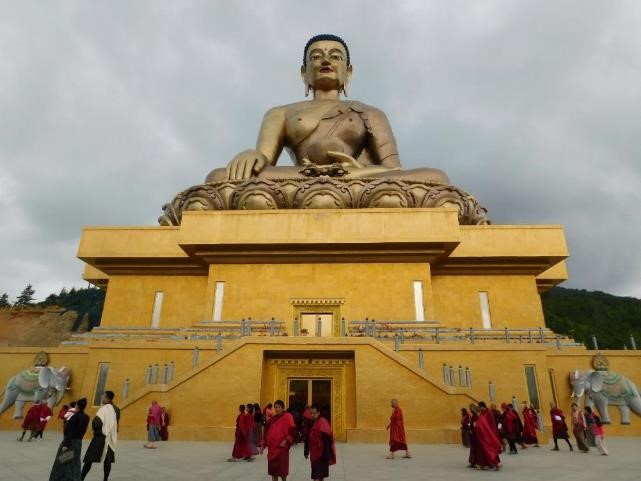
Day 02: Thimphu
In the morning, after breakfast, head **north of the city by road to Buddha Dordenma**, located atop a hill in the Kuenselphodrang Nature Park. This statue fulfills an ancient prophecy dating back to the 8th century A.D., discovered by Terton Pema Lingpa (Discoverer of Religious Treasures), and is said to emanate an aura of peace and happiness for the entire world.
This enormous Shakyamuni statue, made of bronze and gilded in gold, stands 51.5 meters high, making it one of the largest statues in Bhutan. Additionally, 125,000 smaller Buddha statues have been placed inside the Buddha Dordenma statue, each also cast in bronze and gilded in gold.
Travel by road to Pangri Zampa. This monastery complex was founded in the early 16th century and houses an educational institute of the central monastic body to study traditional Bhutanese astrology. The founder of Pangri Zampa initially named the monastery Druk Phodrang, meaning "Dragon Castle," and it was visited by Zhabdrung Ngawang Namgyal (the unifier of Bhutan) in 1616 A.D.
Every year, the institute publishes the official Bhutanese calendar and determines the dates of important national events. Locals visit the monastery to learn about their annual predictions regarding fortune, wealth, health, career, and more. A nine-day ritual is held here annually for the well-being of all sentient beings, as well as for peace and prosperity in the country. Travelers also visit the monastery to discover predictions about their future, often finding themselves surprised by the accuracy of the astrologers.
On the way back, stop to visit Drubthob Goema / Zilukha Nunnery. Perched on a promontory, it overlooks the scenic Trashichhoedzong and the golf course (it is the only nunnery in the capital known as Zilukha Anim Dratsang). In the past, it belonged to Drubthob (a realized one) Thang Thong Gyalpo, often referred to as the King of the Open Field (in the early 15th century, with his many talents, he became popularly known as the Leonardo da Vinci of the Greater Himalayas). Here, you can interact with some of the nuns who have dedicated their lives to spirituality and Buddhism.
After lunch, discover Bhutan’s traditional craftsmanship with a visit to the National Institute of Zorig Chusum. Established in 1971, it is the main institute for preserving and promoting the country’s thirteen traditional arts and crafts. Commonly known as the School of Arts and Crafts or the Painting School, the institute offers 4 to 6-year courses in Bhutan’s 13 traditional arts and crafts.
Next, visit the Folk Heritage Museum, dedicated to connecting people with Bhutan's rural past through exhibitions, demonstrations, educational programs, and documentation of rural life.
Conclude the day with a visit to Trashichhoedzong, the "fortress of the glorious religion." This is the center of government and religion, the site of the monarch’s throne room, and the headquarters of the Je Khenpo or Chief Abbot. Built in 1641 by Bhutan’s political and religious unifier, Zhabdrung Ngawang Namgyal, it was rebuilt in the 1960s using traditional Bhutanese methods, without nails or architectural plans.
Free time in the city center of Thimphu.
Overnight at the hotel in Thimphu (Altitude: 2,320m).
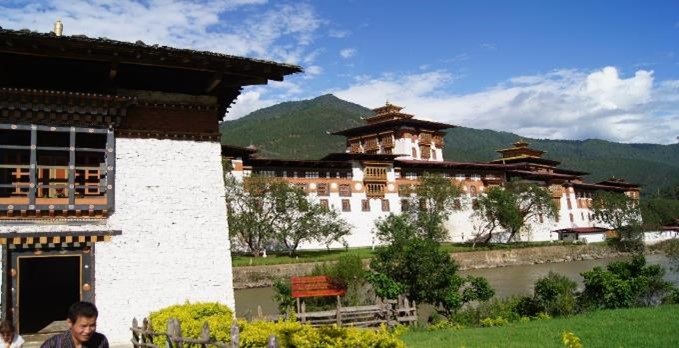
Day 03: Thimphu – Punakha (75 km, approx. 2 ½ hours by car)
After breakfast, drive to the Dochu-la pass (3,088 m / 10,130 ft) with a brief stop to enjoy the view and admire the chorten, the mani wall, and prayer flags that adorn the highest point of the road. If the sky is clear, the following peaks can be seen from this pass (from left to right): Masagang (7,158 m), Tsendagang (6,960 m), Terigang (7,060 m), Jejegangphugang (7,158 m), Kangphugang (7,170 m), Zongphugang (7,060 m), and finally Gangkar Puensum, the highest peak in Bhutan at 7,570 m.
At the Dochula pass, there are 108 chortens or stupas known as the Druk Wangyal Chortens. They were built by Ashi Dorji Wangmo Wangchuk, the country’s longest-reigning Queen Mother. These chortens are constructed in three layers: the first lower level has forty-five chortens, the second has thirty-six, and the upper layer has twenty-seven, built around the main chorten.
Then, continue your journey to Punakha. Punakha served as the capital of Bhutan and the seat of government until 1955 and remains the winter seat of the Je Khenpo (the Chief Abbot). This region is blessed with a temperate climate, and due to its natural drainage by the Pho Chhu (male) and Mo Chhu (female) rivers, the Punakha valley produces abundant crops and fruits. Located at an altitude of 1,300 m above sea level, Punakha enjoys mild winters and is a popular destination year-round.
Travel by road to Pangri Zampa. This monastery complex was founded in the early 16th century and houses an educational institute of the central monastic body to study traditional Bhutanese astrology. The founder of Pangri Zampa initially named the monastery Druk Phodrang, meaning "Dragon Castle," and it was visited by Zhabdrung Ngawang Namgyal (the unifier of Bhutan) in 1616 A.D.
Every year, the institute publishes the official Bhutanese calendar and determines the dates of important national events. Locals visit the monastery to learn about their annual predictions regarding fortune, wealth, health, career, and more. A nine-day ritual is held here annually for the well-being of all sentient beings, as well as for peace and prosperity in the country. Travelers also visit the monastery to discover predictions about their future, often finding themselves surprised by the accuracy of the astrologers.
On the way back, stop to visit Drubthob Goema / Zilukha Nunnery. Perched on a promontory, it overlooks the scenic Trashichhoedzong and the golf course (it is the only nunnery in the capital known as Zilukha Anim Dratsang). In the past, it belonged to Drubthob (a realized one) Thang Thong Gyalpo, often referred to as the King of the Open Field (in the early 15th century, with his many talents, he became popularly known as the Leonardo da Vinci of the Greater Himalayas). Here, you can interact with some of the nuns who have dedicated their lives to spirituality and Buddhism.
After lunch, discover Bhutan’s traditional craftsmanship with a visit to the National Institute of Zorig Chusum. Established in 1971, it is the main institute for preserving and promoting the country’s thirteen traditional arts and crafts. Commonly known as the School of Arts and Crafts or the Painting School, the institute offers 4 to 6-year courses in Bhutan’s 13 traditional arts and crafts.
Next, visit the Folk Heritage Museum, dedicated to connecting people with Bhutan's rural past through exhibitions, demonstrations, educational programs, and documentation of rural life.
Conclude the day with a visit to Trashichhoedzong, the "fortress of the glorious religion." This is the center of government and religion, the site of the monarch’s throne room, and the headquarters of the Je Khenpo or Chief Abbot. Built in 1641 by Bhutan’s political and religious unifier, Zhabdrung Ngawang Namgyal, it was rebuilt in the 1960s using traditional Bhutanese methods, without nails or architectural plans.
Free time in the city center of Thimphu.
Overnight at the hotel in Thimphu (Altitude: 2,320m).
Day 03: Thimphu – Punakha (75 km, approx. 2 ½ hours by car)
After breakfast, drive to the Dochu-la pass (3,088 m / 10,130 ft) with a brief stop to enjoy the view and admire the chorten, the mani wall, and prayer flags that adorn the highest point of the road. If the sky is clear, the following peaks can be seen from this pass (from left to right): Masagang (7,158 m), Tsendagang (6,960 m), Terigang (7,060 m), Jejegangphugang (7,158 m), Kangphugang (7,170 m), Zongphugang (7,060 m), and finally Gangkar Puensum, the highest peak in Bhutan at 7,570 m.
At the Dochula pass, there are 108 chortens or stupas known as the Druk Wangyal Chortens. They were built by Ashi Dorji Wangmo Wangchuk, the country’s longest-reigning Queen Mother. These chortens are constructed in three layers: the first lower level has forty-five chortens, the second has thirty-six, and the upper layer has twenty-seven, built around the main chorten.
Then, continue your journey to Punakha. Punakha served as the capital of Bhutan and the seat of government until 1955 and remains the winter seat of the Je Khenpo (the Chief Abbot). This region is blessed with a temperate climate, and due to its natural drainage by the Pho Chhu (male) and Mo Chhu (female) rivers, the Punakha valley produces abundant crops and fruits. Located at an altitude of 1,300 m above sea level, Punakha enjoys mild winters and is a popular destination year-round.
Overnight at the hotel in Punakha (Altitude: 1200m).
Day 04: Punakha - Paro (125 km, approx. 4 hours by car)
After breakfast, visit Wangduephodrang Dzong. Founded by Zhabdrung Ngawang Namgyal in 1638, it is situated atop a mountain between the Punak Tsang Chhu and Dang Chhu rivers, offering a fantastic panoramic view of the valley. The strategic location of the dzong provided the Penlop (governor) of Wangduephodrang the opportunity to protect the routes to Trongsa, Punakha, Dagana, and Thimphu, making him the third most powerful ruler after the governors of Paro and Trongsa. The dzong was damaged by a fire in 2012 and restored in 2022, regaining its original grandeur and splendor.
Drive to Paro (a journey with wonderful views).
Make a stop en route to visit Simtokha Dzong: Located 5 km south of Thimphu, it was built in 1629 by Zhabdrung Ngawang Namgyal. Officially known as Sangak Zabdhon Phodrang (Palace of the Profound Meaning of Secret Mantras), Simtokha is considered the first dzong built in Bhutan. In fact, it is also the oldest dzong that has survived the passage of time while maintaining its complete structure. Its utse (central tower) rises three stories high, and the prayer wheels surrounding the courtyard are backed by more than 300 finely crafted slate carvings.
The beautiful Paro Valley is rich in culture, scenic beauty, and hundreds of myths and legends. It is home to some of the oldest temples and monasteries in the country, the National Museum, and Bhutan's only international airport. Mount Chomolhari (7,314 m) dominates the northern end of the valley, with its glacial waters plunging through deep gorges to form the Pa Chhu (Paro River). Paro is also one of the kingdom’s most fertile valleys, producing much of the renowned red rice from its fields.
After lunch, proceed to visit Ta Dzong, originally built as a watchtower, now housing the National Museum. The extensive collection includes ancient thangka paintings, textile art, weapons and armor, household items, and a rich variety of historical artifacts.
Continue with a short walk along the trail to visit Rinpung Dzong (Paro Dzong), which means "Fortress of the Heap of Jewels." Along the wooden galleries lining the inner courtyard, you will find fine murals illustrating Buddhist traditions, such as the Four Friends, the Elder of Longevity, the Wheel of Life, scenes from the life of Milarepa, Mount Sumeru, and the Cosmic Mandala.
Overnight at the hotel in Paro (Altitude: 2,280m).
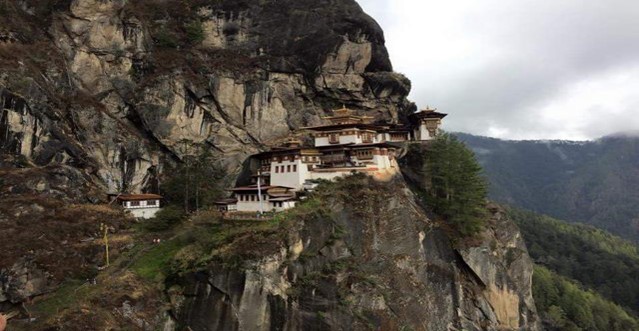
Day 05: Paro
After breakfast, enjoy an excursion to the Taktshang Monastery or Tiger’s Nest (approx. 5-hour round trip hike). This is one of Bhutan’s most famous monasteries, perched on the side of a cliff 900 meters above the Paro Valley floor. Legend has it that Guru Rinpoche arrived here on the back of a tigress and meditated in this monastery, which is why it is called the 'Tiger’s Nest.' This place is considered the most sacred and was visited by Zhabdrung Ngawang Namgyal in 1646.
In the afternoon, drive to the newly restored Drukgyel Dzong. It was built by Zhabdrung Ngawang Namgyal in 1646 to commemorate an early military victory over Tibetan invaders.
This Dzong stood the test of time in its full splendor and appeared in National Geographic magazine in 1914.** The glory of Drukgyel Dzong remained even after it was destroyed by a fire in 1951. On a clear day, visitors can enjoy the lush view of Mount Chomolhari.
On the way back to the city, make a stop to visit Kyichu Lhakhang: It is one of the oldest and most sacred shrines in the Kingdom, dating back to the 7th century (the other is Jambey Lhakhang in Bumthang). The Lhakhang complex consists of two temples. The first temple was built by Tibetan King Songtsen Gampo in the 7th century, and in 1968, Her Majesty Ashi Kesang, the Queen Mother of Bhutan, built the second temple following the original design.
Overnight at the hotel in Paro (Altitude: 2,280m).
Day 06: Depart Paro
After breakfast, transfer to the airport for your flight to your next destination.
Closing Days for Some Monuments Mentioned in the Itinerary:
The quoted price are based on DBL sharing and in USD:
| Travel Period | Category | DBL sharing Cost | Single Supplement |
|---|---|---|---|
| 1 Apr 2025 to 30 Sep 2025 |
Standard | $1265 PP | $250 Per Single |
| Superior | $1750 PP | $390 Per Single |
Internal flight:
| Supplement for flight on sector Delhi – Paro-Delhi in economy class. (Subject to change at the time of issuance) |
| $ 630 PP |
Hoteles Foreseen:
| City | Hotel | Category | Nights |
|---|---|---|---|
| Thimphu | Hotel Phuntsho Pelri | Standard / 4* | 2 |
| Bhutan Peaceful Residency & Spa | Superior / 5* | ||
| Punakha | Zhingkham Resort | Standard / 4* | 1 |
| Dragon’s Nest Resort | Superior / 5* | ||
| Paro | Paro Eco Lodge | Standard / 4* | 2 |
| Hotel Olathang | Superior / 5* |
Note: Base category is foreseen at all the hotels.
The Price Includes:
Not Included:
Third Person/Child Conditions: